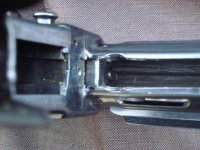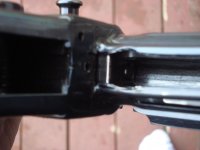My PTR op rod ears broke off a while back. Was able to get another PTR op rod to replace it. I didn't feel good about shooting with it, so I considered doing things right. After some wincing and gnashing of teeth (caused the over the prices), I found and purchased, over time, an original MP44 op rod, bolt, and ejector on Gun Broker. Thanks to some great articles by you guys here, and on other sites, I got a finer insight as to what was going on in the MP/PTR's inner workings. I removed the blocking tabs at the rear of the receiver a while back and put in the op rod and bolt. The bolt just rode too high in the receiver with PTR's ejector in it, and the front of the bolt fit way too tight when closed. Well what next? Some more time passes. After reading how to remove the locking block and ejector thanks to you guys articles, I mulled over this for a time and let things sit. So, after a bit more time, and with some consternation, I took out the retaining pins, and tapped out the ejector and locking block and looked around in the receiver. It was a bit claustrophobic, but I installed the MP44 ejector, replaced the locking block, and then put in the op rod/bolt. Everything just FIT FINE. No slop, op rod/bolt bolt rode back and forth great, only a little tight closing in the locking block area. I drilled the ejector in place and reinstalled the pins. Went out and shot it several times the next day and me oh my. It just shot like it should have in the first place. No FTFs, No FTEs No anomalous sputterings. After I got home, I checked everything out and all was fine, and the test firing did a little set back on the locking block so the bolt now closes smooth as butter. Thanks all for the gleaned information I used. All's not done to it yet, but I now have a real shooter after 6 years.








